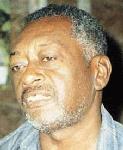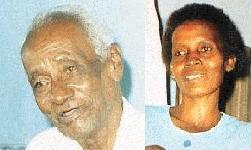



Somewhere in Puttalam there lives a small community. They are the Kaffirs. Scholars trace their roots back to Mozambique in Africa. Jennifer Paldano writes:
Sri Lanka is often described as a multi ethnic society. And certainly not without reason. Sinhalese, Tamils, Muslims and Burghers apart, a quick look through a census report, would reveal that the last column described as ‘others’ accommodates groups of people the majority of Sri Lankans are not familiar with. Often the population in these communities does not even exceed one hundred.
It is likely that some minority groups settled here either during the days of our monarchs, when the country was constantly exposed to foreign invasion or were subsequently brought by the Portuguese, Dutch and the British. These groups have integrated into the larger social fabric and adopted the local way of living. They can hardly be considered foreign except for their distinctive facial features.
A small group of one such community, the Kaffirs, is settled in Sellankandal in Serambiyadi in the Puttalam District. Their features are more akin to the natives of Mozambique and Angola. Although the colour of their skin has lightened over the years, they look similar to Africans, having flat thick lips, bulging eyes and curly hair. Relying on their appearance and other historical information, Dr. K.D. Paranavithana, former Assistant Director, National Archives, said that it is more likely that the Kaffirs would have been brought here from Mozambique.
 M.
G. Elias
M.
G. Elias
61-year-old M.G. Elias said they once had visitors from
Nigeria, who may have heard about the Kaffirs and wanted to trace their roots.
“I’m a pensioner and my brothers and sisters are also pensioners. We worked for the British and today we are enjoying a pension. But now government jobs are rarely available and our youth have to either travel to the Middle East or move away from Puttalam. There are two members who are doing quite well in the Police and health sector,” said Elias.
 Raphael
and daughter
Raphael
and daughter
The only remaining tradition they treasure is their song
and dance. As such the Puttalam Kaffirs have their own style of celebrating.
Their songs are mistaken for Baila, whereas they are known as ‘manja’.
According to 83-year-old B.M. Raphael, a celebration in their community sees
all of them holding each other and dancing in circles. This, he smiles, is a bit
awkward for the Sinhalese.
The community are Catholic and Elias recalls that returning after midnight Christmas mass, the few members living close by would celebrate with music. But such occasions too are increasingly rare, as families are increasingly split up, some having moved to areas like Trincomalee, Kala Oya and Third Mile Post.
Raphael’s daughter adding bits of information to our conversation said that most of the younger generation had studied in the Sinhala medium in the local school. As for her, she remembers nothing about her ancestry. “We have lived in Puttalam for a long time and do not feel different to any one else. When people question us about our roots we don’t have much to say, because whatever versions we hear from our parents and grandparents differ. On the other hand, we have no use of our ancestry to survive. If we don’t feel different, there’s no problem of living with others,” she said.
The Kaffirs have adopted the local dress. The older generation wore the English dress and suit complete with hat and gloves for their weddings. But now since most young Kaffirs find their partners outside their community, as brides they opt for the saree. Of course they celebrate their weddings in style. The older members remember their ‘majna’ and singing and dancing is inevitable at a ceremony.
As a community the Kaffirs are not wealthy. Except for a few houses made of brick, the rest are made of wood. Those who have built their houses, have done so because a member of the family has either worked in the Middle East or worked outside. The Kaffirs attribute their poor status to the lack of stable jobs. They feel that they have been overlooked and neglected.
There is little documentation of the Kaffirs in Sri Lanka or Ceylon. A short study done in the 1970s by Dr. K.D. Paranavithana and Dr. M.H. Goonatilleka gives an insight into the language once spoken by this community. The language of the Kaffirs is similar to Portuguese, although it can be described as a Creole. As no extensive study has been done on the Kaffirs, their arrival to the island is interpreted in different ways.
B.M. Raphael recalled what he had gathered about his ancestors’ arrival to the island. He claims that they had been brought from Madagascar, an island East of Mozambique, during the Boer war. They were brought here, he said, for their safety. They had landed at ‘Vellakaran Kuda’ in Puttalam.
“Men had landed unaccompanied by their families. They were handed over to an aristocrat, Rathnayake Mudiyanse, upon arrival. Once settled, they had been given jobs at the saltern, kachcheri and in the homes of foreigners. I came across another Black community in Kandy while I was serving in the Army during the second world war. They laughed at me accusing me of pretending to be of their stock. They were much darker, whereas we had changed after marrying locals,” said Raphael.
M.G. Elias’s version seems to be more accurate. Although he wasn’t sure of the period of arrival, he said that his ancestors were sent to Ceylon by the Portuguese as slaves to construct the railway line in Puttalam. He claims that the Kaffirs were brought in chains and subsequently weaned out of their tribal customs and beliefs by the missionaries. Some of his ancestors had later worked in the homes of foreigners and in the kachcheri.
The Kaffirs are Roman Catholics, a direct result of their contact with the Portuguese. Reliable evidence can be gathered from accounts on Mozambique in books. Mozambique was penetrated by the Portuguese in the late 15 century and gained independence only in 1975. In the early 19 century Portugal had transferred the administration of the country to private companies. These companies with the principal aim of earning high profits used it as a trade route and the inhabitants as cheap labour to British colonies (Source- World Atlas of Nations). As such there is some credibility to Elias’s account. It is probable that the Kaffirs were sent by a private company to Ceylon, then a British colony, as cheap labour to construct the railway.
The dialect spoken by the Puttalam Kaffirs has different features at the levels of grammar, phonology and morphology, pointed out Dr. Paranavithana. It must be noted that upto the 12th century there was no written form of language in Portugal, but language existed only in spoken form. It was only during the 12th and 15th centuries that the spoken language was transferred to written form. As such Dr. Paranavithana pointed out that the Portuguese dialect of the Kaffirs resembles the early spoken form of language that existed in Portugal prior to the 12th century.
The members of the community claim that so far they have lived peacefully among Sri Lankans. Their distinct facial features often earn them curious looks, from strangers, but in Puttalam they are a familiar sight. Most of the older members are pensioners, while some of the younger members have moved to Colombo, while some others are travelling to the Middle East in search of better prospects. In short the Kaffirs have completely integrated into the larger Sri Lankan society Today they converse in Sinhala and their Creole is limited to community functions. With the passing away of older members, however, the dialect of the Kaffirs too may soon disappear.
Continue to Plus page 2 - When the oppressor was taken by surprise






Please send your comments and suggestions on this web site to
info@suntimes.is.lk or to
webmaster@infolabs.is.lk